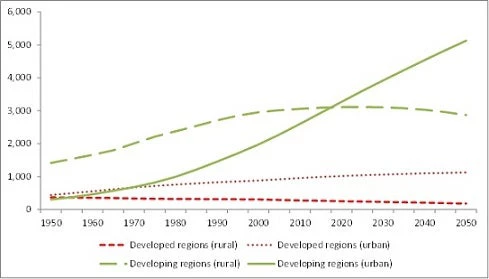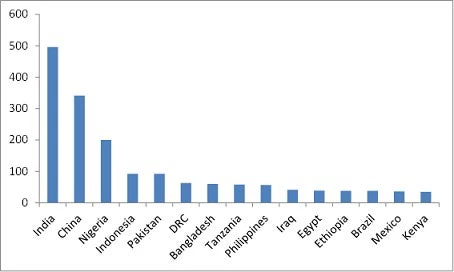Driven by the rapid growth of urban population in developing countries, the world had become more urban than rural by 2007. This trend is expected to continue in the years ahead. Almost all of the future growth in the world population will be concentrated in the urban areas of developing countries. The United Nations projects that developing countries will almost double their urban population by 2050, adding a further 2.4 billion urban dwellers (figure 1).
While the urbanization of the world’s population has been accompanied by an “urbanization of global poverty” (Ravallion et al., 2007), poverty continues to be overwhelmingly concentrated in rural areas. According to the World Development Indicators, almost two third of the poor globally are still rural. Thus understanding the implications of urban growth for rural poverty in developing countries is crucial for any global poverty reduction strategy. That is what Carlo Menon and I try to do in a recent paper, examining the extent to which the growth in urban areas reduced poverty in surrounding rural areas in India (Calì and Menon, 2013). The focus on India is particularly relevant, as it is the country with the largest number of both rural and urban poor and with the largest expected absolute growth in urban population between now and 2050 (figure 2).
Figure 1: Urban and rural populations (in mln) by development group, 1950-2050
Source: World Urbanization Prospects, the 2011 Revision
Using data on Indian districts from 1983 to 1999, we find that urbanization has a significant poverty-reducing effect in the surrounding rural areas. We use a variety of instrumental variable estimations to show that this effect is causal and in fact failure to control for causality downwardly biases the poverty reducing effect of urbanization. On average an increase in the urban population by 200,000 determines a decrease in rural poverty in the same district of between 1.3 and 2.6 percentage points. According to these figures, urbanization was responsible for between 13 percent and 25 percent of the overall reduction in rural poverty in India over the period. This is a substantial contribution, which is higher for example than that of an important rural policy in post-independence India, i.e. land reform, which explains approximately one-tenth of the rural poverty reduction between 1958 and 1992 (Besley and Burgess, 2000).
Figure 2: Largest expected changes in urban population (in mln) in developing countries, 2010-2050
Source: World Urbanization Prospects, the 2011 Revision
Our analysis suggests that the poverty-reducing impact of urbanization is a consequence of urban-rural economic linkages and it is not due to the re-location of the rural poor to urban areas. Distinguishing between these two effects is important. The latter entails no structural link between urbanization and rural poverty and the related variation in rural poverty is simply due to the change in residency from rural to urban areas of some of the rural poor. On the other hand, the economic linkage effects capture the impact of urbanization on the welfare of those who remain in rural areas through urban-rural linkages. This relationship indicates how good or bad urbanization is for rural poverty.
We find that these economic linkage effects of urbanization on rural poverty are entirely accounted for by four channels. The first is due to the increase in the demand for rural goods by an expanding urban area, which in the absence of spatially integrated food markets, is disproportionately satisfied by surrounding rural areas. This channel alone explains around three quarter of the overall effect of urbanization on rural poverty. The second mechanism works through urban-rural remittances associated with urbanization, which account for less than a fifth of the rural poverty reducing effect of urbanization. The remaining small proportion of the effect of urbanization on rural poverty is explained by the increase in rural land/labor ratio due to rural-urban migration and to the increase in rural nonfarm employment. Expanding urban areas usually favor the diversification of economic activity away from farming in surrounding rural areas, which typically has a positive effect on income. In the case of India, this effect is small as rural nonfarm employment has an inverted-U shape relation with rural poverty.
These findings suggest at least two policy messages. First, they can help to reassess the role of public investment in urban areas for poverty reduction. In fact, it is a popular tenet that investments in developing countries should be concentrated in rural areas to reduce poverty because the poor in developing countries are primarily concentrated there. However to the extent that urbanization can have substantial poverty-reducing effects on rural areas, urban investments should become an important complement to rural investments in rural poverty-reduction strategies. Second, our findings run counter the popular myth that rural-urban migration may deplete rural areas, causing them to fall further behind. The relatively low rate of urbanization in India itself (and in China) is likely to be due at least in part to public policies that have not facilitated (and, in certain instances, have even constrained) rural-urban migration. At the very least, this paper questions the appropriateness of this bias against rural-urban migration.
References
Besley, T., and R. Burgess. 2000. “Land Reform, Poverty Reduction and Growth: Evidence from India”.
Quarterly Journal of Economics, 117(4): 389–430.
Calì, M. and C. Menon (2013). “Does Urbanization Affect Rural Poverty? Evidence from Indian Districts”. World Ban Policy Research Working Paper 6338 (also forthcoming in the World Bank Economic Review).
Ravallion, M., S. Chen, and P. Sangraula (2007). “New evidence on the urbanisation of global poverty”. Population and Development Review, 33(4): 667–701.




Join the Conversation